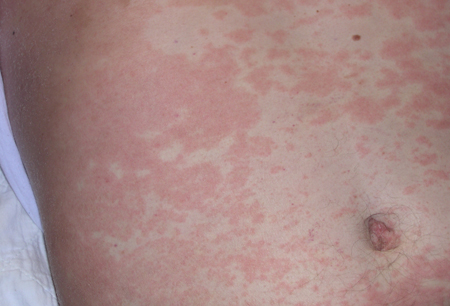შეჯამება
განსაზღვრება
ანამნეზი და გასინჯვა
ძირითადი დიაგნოსტიკური ფაქტორები
- რისკ-ფაქტორების არსებობა
- წამლის მიღების ანამნეზი
- კანის დაზიანებები
- სხვადასხვანაირი დერმატოლოგიური რეაქცია წამლის მიღებიდან 5-15 წუთში
- სხვადასხვანაირი დერმატოლოგიური რეაქცია წამლის მიღებიდან რამდენიმე საათში
- სხვადასხვანაირი დერმატოლოგიური რეაქცია წამლის მიღებიდან 2 კვირაში
- სხვადასხვანაირი დერმატოლოგიური რეაქცია წამლის მიღებიდან თვეების, ან წლების შემდეგ
- წამლის ადრე მიღება და მისდამი განვითარებული რეაქცია
სხვა დიაგნოსტიკური ფაქტორები
- ქავილი
- ასოცირებული არადერმატოლოგიური მონაცემები
- ტკივილი
რისკფაქტორები
- ვირუსული ინფექცია
- HIV ინფექცია
- HLA-B*5701 პოლიმორფიზმი
- HLA-B*1502 პოლიმორფიზმი
- HLA-B*5801 პოლიმორფიზმი
- მდედრობითი სქესი.
დიაგნოსტიკური კვლევები
გასათვალისწინებელი კვლევები
- სისხლში(მთლიანი სისხლი, შრატი, პლაზმა) წამლის შემცველობა
- შრატში ტრიპტაზის შემცველობა(ანაფილაქსია)
- კომპლემენტის აქტივაციის კვლევა
- დაზიანებების ბიოფსიის ჰისტოლოგიური მონაცემები
- სისხლის საერთო ანალიზი (FBC) ლეიკოციტური ფორმულით
- ანტიჰისტონური ანტისხეულები ერთძაფიანი დნმ მიმართ(მგლურას მსგავსი სინდრომი)
- კანის სინჯები(სკარიფიკაციული ტესტები, ინტრადერმული სინჯები, კეროვანი ტესტები)
ახალი ტესტები
- წამლისთვის დამახასიათებელი IgE
- ბაზოფილური აქტივაციის ტესტი
- ლიმფოციტების პროლიფერაციის გამოკვლევა (LPA/LTT)
- ანზიმთან დაკავშირებული იმუნოსპოტური კვლევა(ELISPOT ტესტი)
მკურნალობის ალგორითმი
სერიოზული დერმატოლოგიური გვერდითი მოვლენები
არამძიმე დერმატოლოგიური გვერდითი მოვლენები
მწვავე ეპიზოდის შემდეგ
კონტრიბუტორები
ავტორები
Michael Ardern-Jones, BSc, MBBS, DPhil, FRCP
Associate Professor
Consultant Dermatologist
Faculty of Medicine
University of Southampton
Southampton
UK
გაფრთხილება:
MA-J declares that he has no competing interests.
მადლიერება
Dr Michael Ardern-Jones would like to gratefully acknowledge Dr Wei Yann Haw, Dr Anne Holbrook, Dr Hermenio Lima, and Dr Jeffrey K. Aronson, the previous contributors to this topic.
გაფრთხილება:
WYH, AH and HL declare that they have no competing interests. JKA is editor of Meyler's Side Effects of Drugs and its annual companion volumes, the Side Effects of Drugs Annuals.
რეცენზენტები
Shahbaz A. Janjua, MD
Specialist Dermatologist
Ayza Skin & Research Center
Lalamusa
Pakistan
გაფრთხილება:
SAJ declares that he has no competing interests.
Craig K. Svensson, Pharm.D, PhD
Dean
College of Pharmacy, Nursing, and Health Sciences
Purdue University
West Lafayette
IN
გაფრთხილება:
CKS declares that he has no competing interests.
რეცენზენტების განცხადებები
BMJ Best Practice-ის თემების განახლება სხვადასხვა პერიოდულობით ხდება მტკიცებულებებისა და რეკომენდაციების განვითარების შესაბამისად. ქვემოთ ჩამოთვლილმა რეცენზენტებმა თემის არსებობის მანძილზე კონტენტს ერთხელ მაინც გადახედეს.
გაფრთხილება
რეცენზენტების აფილიაციები და გაფრთხილებები მოცემულია გადახედვის მომენტისთვის.
წყაროები
ძირითადი სტატიები
Aronson JK, Ferner RE. Joining the DoTS: new approach to classifying adverse drug reactions. BMJ. 2003 Nov 22;327(7425):1222-5. აბსტრაქტი
Gell PG, Coombs RRA, eds. Clinical aspects of immunology. 1st ed. Oxford: Blackwell; 1963.
Bigby M, Jick S, Jick H, et al. Drug-induced cutaneous reactions: a report from the Boston Collaborative Drug Surveillance Program on 15,438 consecutive inpatients, 1975 to 1982. JAMA. 1986 Dec 26;256(24):3358-63. აბსტრაქტი
Kuokkanen K. Drug eruptions: a series of 464 cases in the Department of Dermatology, University of Turku, Finland, during 1966-1970. Acta Allergol. 1972 Dec;27(5):407-38. აბსტრაქტი
Aronson JK, Ferner RE. Clarification of terminology in drug safety. Drug Saf. 2005;28(10):851-70. აბსტრაქტი
Khan DA, Banerji A, Blumenthal KG, et al. Drug allergy: a 2022 practice parameter update. J Allergy Clin Immunol. 2022 Dec;150(6):1333-93.სრული ტექსტი
Naranjo CA, Busto U, Sellers EM, et al. A method for estimating the probability of adverse drug reactions. Clin Pharmacol Ther. 1981 Aug;30(2):239-45. აბსტრაქტი
Hill AB. The environment and disease: association or causation? Proc R Soc Med. 1965 Jan;58(1):295-300.სრული ტექსტი აბსტრაქტი
Howick J, Glasziou P, Aronson JK. The evolution of evidence hierarchies: what can Bradford Hill's 'guidelines for causation' contribute? J R Soc Med. 2009 May;102(5):186-94.სრული ტექსტი აბსტრაქტი
National Institute for Health and Care Excellence. Drug allergy: diagnosis and management. September 2014 [internet publication].სრული ტექსტი
გამოყენებული სტატიები
ამ თემაში მოხსენიებული წყაროების სრული სია ხელმისაწვდომია მომხმარებლებისთვის, რომლებსაც აქვთ წვდომა BMJ Best Practice-ის ყველა ნაწილზე.

დიფერენციული დიაგნოზები
- სისტემური წითელი მგლურა
- ავტოიმუნური ბლისტერული დაზიანებები
- სტაფილოკოკური დათუთქული კანის სინდრომი
მეტი დიფერენციული დიაგნოზებიგაიდლაინები
- Drug allergy: a 2022 practice parameter
- Emergency treatment of anaphylactic reactions
მეტი გაიდლაინებიშედით სისტემაში ან გამოიწერეთ BMJ Best Practice
ამ მასალის გამოყენება ექვემდებარება ჩვენს განცხადებას